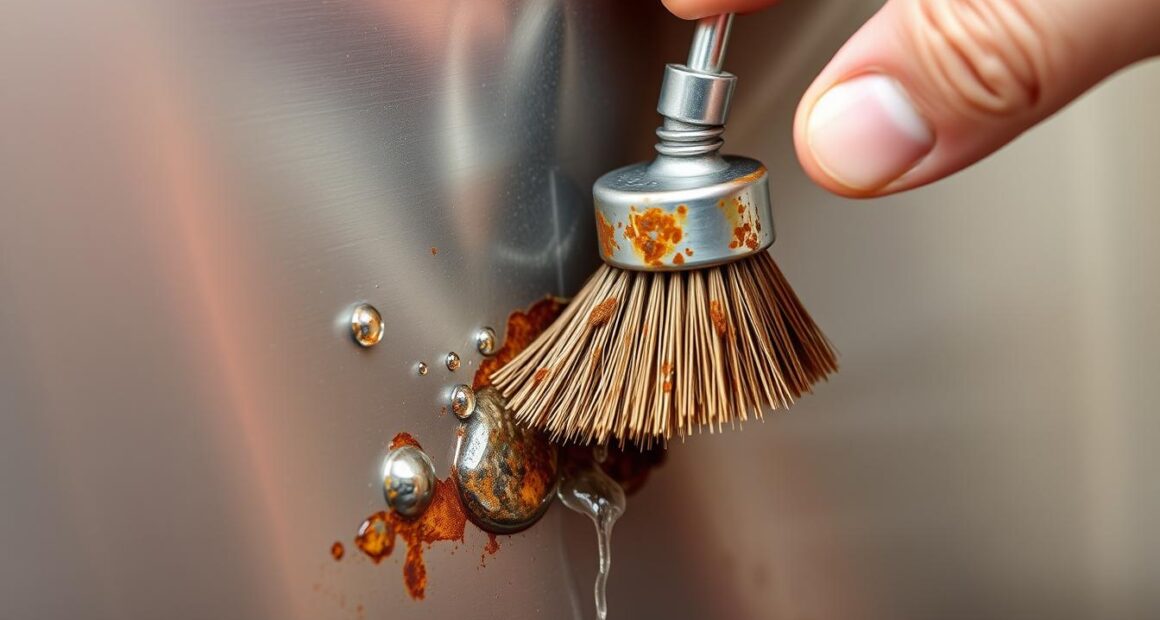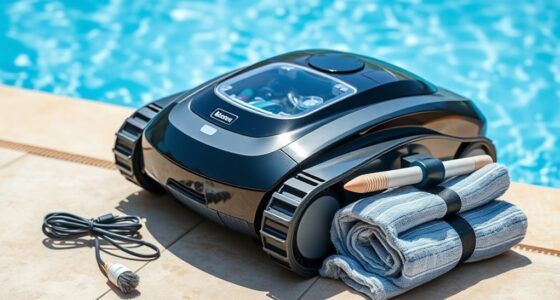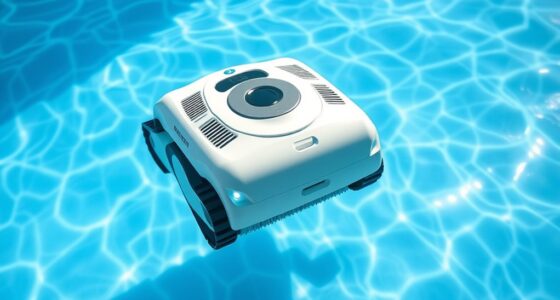Imagine this: you’re looking at your kitchen’s stainless steel, once shiny and full of life, now covered in rust. It’s unpleasant, showing how time and small mistakes like moisture can have big effects. But don’t worry. You’re not alone, and there’s hope. This guide will show you how to get rid of rust and keep it away. We’ll share different methods to make your stainless steel look new again. And with some care, your appliances will not only shine but last longer too. It’s all about using the right approach to remove rust, making your home look great and feeling proud of your well-kept spaces.
Key Takeaways
- Effective rust removal can be achieved using household ingredients like baking soda and lemon juice.
- Regular maintenance and cleaning are vital for rust prevention on stainless steel surfaces.
- Some methods require time to allow ingredients to work effectively, such as letting baking soda sit for at least 30 minutes.
- Commercial rust removers provide a more robust solution for severe rust issues.
- A protective coating can help shield stainless steel from future rust development.
Understanding Rust on Stainless Steel
Rust happens when metals touch moisture and oxygen for long. This issue can happen with stainless steel too. Despite its stainless steel properties, certain conditions weaken its defenses creating rust stains.
Chlorides from saltwater speed up rust on stainless steel. Scratches also make it easy for rust to start.
Knowing how stainless steel properties help stop rust is crucial. Stainless steel has 10% to 30% chromium. It forms a protective layer that stops rust. But, this layer can fail if the metal’s quality is low or mixed wrong.
To prevent rust, keep stainless steel clean. Regular care removes dirt that causes rust. Spending five minutes daily on cleaning can protect your items.
| Condition | Impact on Rust Formation |
|---|---|
| Moisture Exposure | Increases oxidation and corrosion risk |
| Chloride Exposure | Accelerates rust formation |
| Surface Scratches | Creates vulnerability for rust to develop |
| Poor-Quality Alloys | Decreases corrosion resistance |
| Regular Maintenance | Reduces accumulation of contaminants |
Using these steps keeps stainless steel looking good and lasting longer. Knowing these details helps you stop rust. This way, you enjoy stainless steel’s full benefits longer.
Common Causes of Rust on Stainless Steel
Stainless steel is known for fighting off rust, but it’s not perfect. Causes of rust can wear down its defenses. High humidity and salty air can remove its protective chromium oxide layer. This layer is key for stopping rust.
Contact with wet cast iron pans or rusty items can cause rust stains. When deep scratches happen, they expose steel to moisture and salt. Without regular care, contaminants build up and promote rust on stainless steel rust sources.
- Contact with wet cast iron pans or rusty items can lead to noticeable rust stains.
- Deep scratches expose the underlying steel, making it vulnerable to moisture interaction, especially when salt is present.
- The absence of regular maintenance often results in a buildup of contaminants, which contributes to stainless steel rust sources.
Knowing these causes helps in fighting rust prevention. Clean and dry stainless steel right away to lower rust risks. Washing cookware immediately keeps food residues from causing rust. Also, drying items fully helps stop moisture from inviting rust.
| Rust Contributing Factors | Description |
|---|---|
| Humidity | High moisture levels can compromise the protective layer on stainless steel. |
| Salt Exposure | Chloride ions in saltwater can accelerate rust formation. |
| Scratches | Any damage to the surface can initiate rusting. |
| Lack of Maintenance | Failure to clean can lead to the accumulation of corrosive substances. |
| Inferior Quality Steel | Wrong compositions can lead to higher rust susceptibility. |
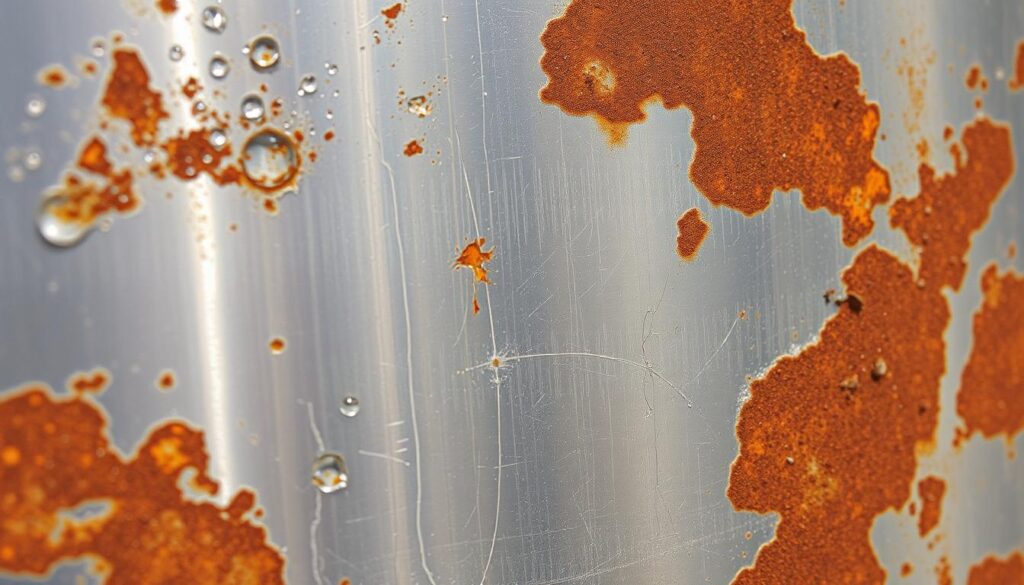
To protect your stainless steel items from rust, address these stainless steel rust sources. Use a polish or cleaner often to boost surface strength. This acts as another guard against rust.
Materials Required for Rust Removal
To effectively remove rust from stainless steel, you need specific materials. These tools make the removal process smoother and faster. Here’s what to gather:
- Baking soda
- Bar Keepers Friend
- Coarse salt
- Dish soap
- Lemon juice
- Microfiber cloth
- Non-abrasive sponge
- Old toothbrush
These items for rust cleaning are quite cheap. Often, they cost less than $10. With these, you can easily clean your stainless steel things and make them shine again. Try different methods with these materials to find what works best for you.
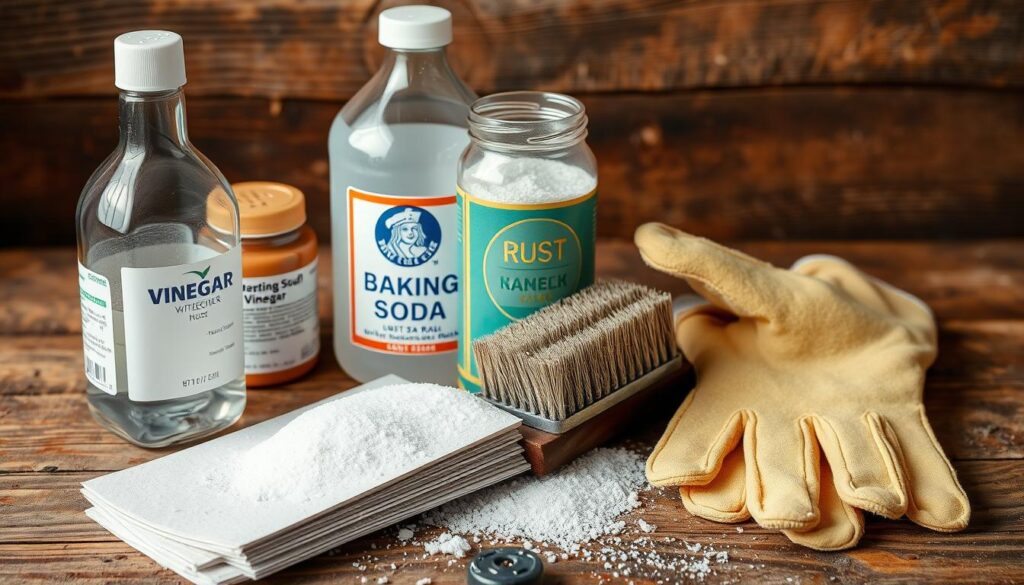
| Material | Purpose | Application Method |
|---|---|---|
| Baking soda | Absorbs moisture and neutralizes rust | Mix with water to create a paste |
| Bar Keepers Friend | Specialized cleaner for stainless steel | Sprinkle on surface, scrub with sponge |
| Coarse salt | Abrasive agent for scrubbing | Mix with lemon juice or vinegar |
| Lemon juice | Naturally acidic for rust removal | Apply directly or use as a soak |
| Microfiber cloth | Safe for polishing and cleaning | Wipe surfaces without scratching |
| Old toothbrush | Reaches small crevices | Scrub edges and tight spots |
By preparing these materials, you can effectively battle rust on your stainless steel items. Use these tools wisely to keep your items clean and shiny for a long time.
Best Way to Remove Rust from Stainless Steel
Rust on stainless steel can be a worry. Yet, there are several good ways to get rid of it. Using things from around the house is cheap and easy. These do-it-yourself solutions let you fight rust without strong chemicals. They also keep your stainless steel looking great.
Using Baking Soda and Water
Baking soda is a top pick for removing rust. Mix 1/2 cup of baking soda with 1 tablespoon of water to make a paste. Spread this paste on the rusty spots, covering them well. Let it sit for about 30 minutes.
Then, scrub it gently with a wet sponge. Make sure to rub in the direction of the metal’s grain to avoid scratches. Rinse it off well and dry with a microfiber cloth. This method will make your stainless steel shine again.
The Role of Lemon Juice and Salt
Lemon juice mixed with salt is also a good way to tackle rust. Mix two parts salt with one part lemon juice to form a strong paste. Slather it on the rust and wait a few hours. The acidic lemon juice and rough salt work together to loosen the rust.
After waiting, scrub softly with a sponge and rinse well. This method is effective and uses natural ingredients.
Potatoes: A Surprising Method
Potatoes are an unexpected but effective cleaning tool. Cut a potato in half and dip it into dish soap. Then, rub the cut side on the rusty spot. The potato’s oxalic acid reacts with the rust, helping to remove it.
Leave the potato on the rust for about four hours. Then, rinse and dry the area. This trick is especially useful for cleaning small, detailed items made of stainless steel.
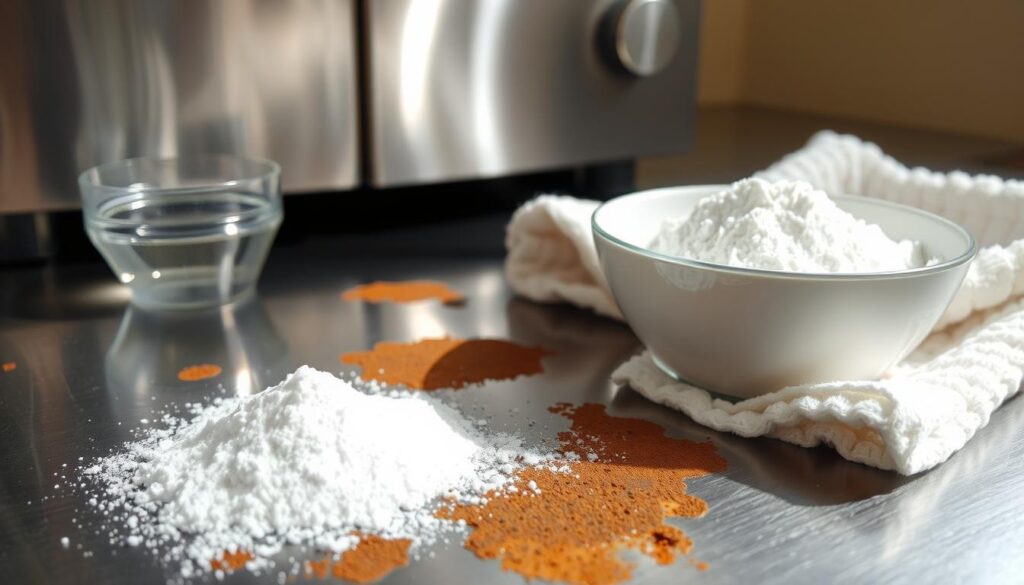
Alternative Rust Removal Methods
Looking for different ways to remove rust can lead you to effective solutions suitable for you. There are household remedies and commercial products tailored for tough rust issues. Here, we delve into two widely used rust removal strategies.
Commercial Products for Rust Removal
For hard-to-remove rust stains, commercial removers are a strong choice. Brands like Bar Keepers Friend and WD-40 have effective rust-targeting formulas. They include acids that work well but are gentle on stainless steel. It’s important to follow the instructions on the label carefully. Remember, some options, like WD-40, aren’t safe for food areas, so be cautious with kitchen appliances.
Using White Vinegar as a Rust Remover
Using white vinegar for rust is an old but effective method. Its acetic acid dissolves rust gently, protecting your surfaces. For great results, let small items soak in vinegar overnight. It loosens the rust for easy removal later. This method is excellent for screws, bolts, and small tools. White vinegar is safe, non-toxic, and budget-friendly, making it a top choice for many.
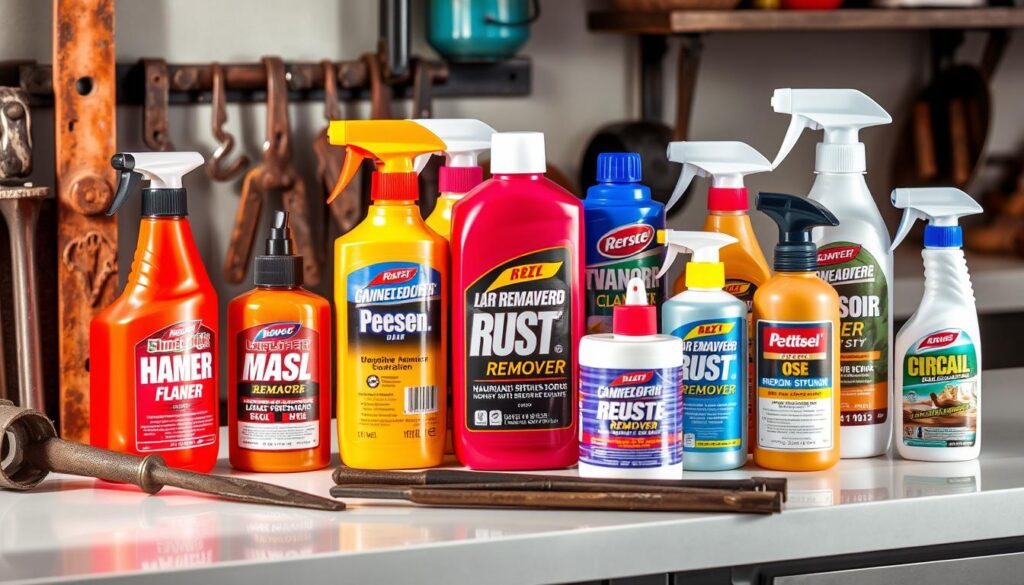
| Method | Effectiveness | Duration |
|---|---|---|
| Commercial rust removers | Up to 90% | 5 minutes to 1 hour |
| White vinegar rust removal | About 70% | 8 to 12 hours |
| Baking soda and water | High effectiveness for light rust | 30 minutes to 1 hour |
How to Prevent Rust in Stainless Steel
Keeping stainless steel rust-free is important. Even though it’s resistant, it can still rust in certain scenarios. Regular cleaning and drying stainless steel after it gets wet is a top tip for rust prevention. If you don’t, moisture might build up and rust could start to form.
Never use steel wool or harsh powders for cleaning. They can scratch the stainless steel. When the surface is damaged, it’s easier for rust to start.
Clean spills right away and dry surfaces fast after they get wet. This keeps moisture down. In places with a lot of saltwater, like the coast, you need to do even more to protect against rust.

| Prevention Strategy | Description |
|---|---|
| Routine Cleaning | Use mild detergents and soft cloths to maintain the passivation layer |
| Immediate Spill Cleanup | Quickly address spills to minimize moisture exposure |
| Avoid Scratching | Steer clear of abrasive tools that can damage the stainless steel surface |
| Monitor Environmental Conditions | Be aware of high chloride levels and adjust care routines accordingly |
| Regular Inspections | Check for scratches or dents that may compromise protection |
Use these rust prevention tips to keep your stainless steel looking new. Taking care of it will help keep the protective layer strong. This makes rust less likely to happen.
Tips for Maintaining Stainless Steel
To keep your stainless steel in top shape, it’s crucial to take good care of it. It helps to know a few key maintenance tips. These tips can help your stainless steel items last longer.
Start by choosing gentle cleaners made for stainless steel. These cleaners stop scratches and keep the surface shiny. Wipe down your stainless steel often to get rid of dust and fingerprints. Ensure it stays dry to prevent rust. If you encounter stubborn residue from stickers or labels, using a gentle adhesive remover can be very effective. Additionally, some of the best methods to remove stickers involve using warm soapy water or a mixture of vinegar and water to help dissolve the adhesive without damaging the surface. Always test any cleaning solution in a small, inconspicuous area first to ensure that it doesn’t harm your stainless steel finish.

Think about using a protective barrier or polish on your stainless steel. Doing this regularly can help stop moisture and corrosion. This makes it less likely for rust to develop. Should rust appear, you can remove it with things you might have at home.
Here is an easy table to help you know the best cleaning products and methods:
| Product/Method | Use | Duration |
|---|---|---|
| Baking Soda Paste | Rust treatment | 30 minutes |
| Cream of Tartar & Vinegar | Rust treatment | 5 minutes |
| Lemon Juice & Salt | Fast rust removal | Varies |
| Oxalic Acid Cleaners | Surface rust removal | As per instructions |
By learning these care tips and cleaning your stainless steel regularly, you can keep it looking great. Your items can stay beautiful and free from rust for many years.
Regular Cleaning Techniques
Keeping stainless steel shiny needs a steady cleaning routine to stop rust. You must clean often to keep your items looking good and working well. Regular care stops colors from fading and metal from corroding.
Start your cleaning with a mix of gentle dish soap and warm water. This blend is perfect for everyday cleaning. Use a microfiber cloth for wiping down surfaces. It makes sure no strong chemicals touch the steel. This way, you get rid of dirt safely and keep the steel in good shape.
If you see hard spots, mix baking soda with water into a paste. Put it on the stubborn areas and wait a bit. Then, softly scrub with a soft cloth. After scrubbing, rinse it off well with clean water. This leaves your steel shiny and without any leftover marks. It’s a key step in stopping rust.
Here’s a table that shows how to clean stainless steel well:
| Cleaning Method | Description | Recommended Frequency |
|---|---|---|
| Mild Dish Soap and Water | Use warm soapy water and microfiber cloth. | Daily/Weekly |
| Baking Soda Paste | Apply paste to tough spots, scrub gently, and rinse. | Weekly/As Needed |
| Citric Acid Solutions | Use products like CitriSurf for rust and passivation. | Monthly/As Needed |
| Vinegar Bath | Soak items in distilled vinegar to lift rust. | Monthly/As Needed |
Using these cleaning tips helps your stainless steel look better and last longer. Keeping up with this maintenance stops rust. It makes sure your stainless steel stays looking great.
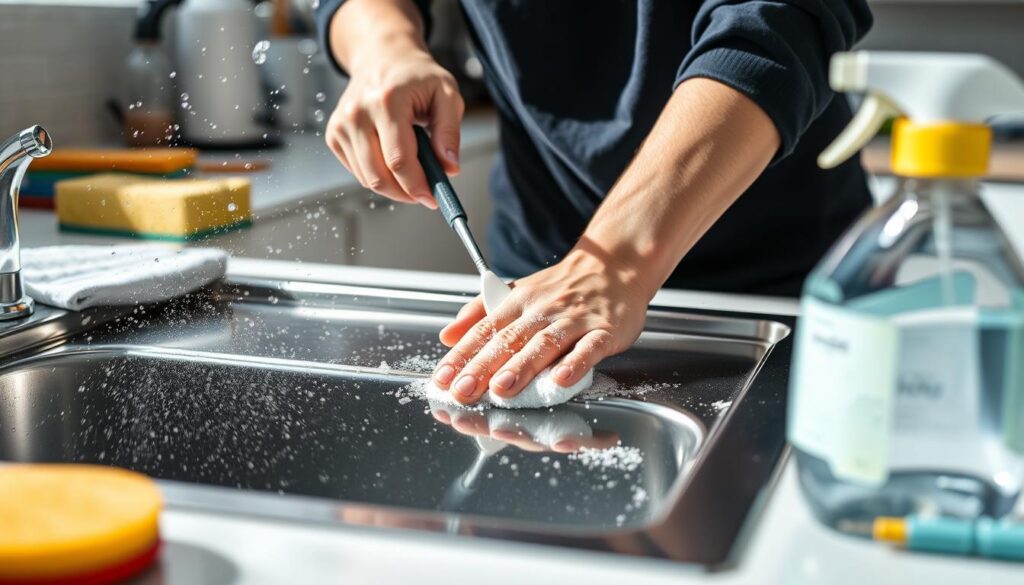
Evaluating Your Rust Removal Success
After you finish removing rust, it’s vital to check how well it worked. Look carefully for leftover rust, color changes, or rough spots. These signs mean the removal might not have been complete. Inspecting closely helps you know if your method worked well or if more work is needed.
To better judge your success, follow these steps:
- Visual Inspection: Look at the steel item in good light to spot any flaws left.
- Touch Test: Feel the surface with your hands to find any uneven areas.
- Check Results from Tests: Look at rust resistance tests, like salt spray tests, to gauge how well the treatment worked.
If you still see problems after the first try, you may need to remove the rust again or try a new method. Staying dedicated to checking regularly helps keep your items looking new and lasting longer.
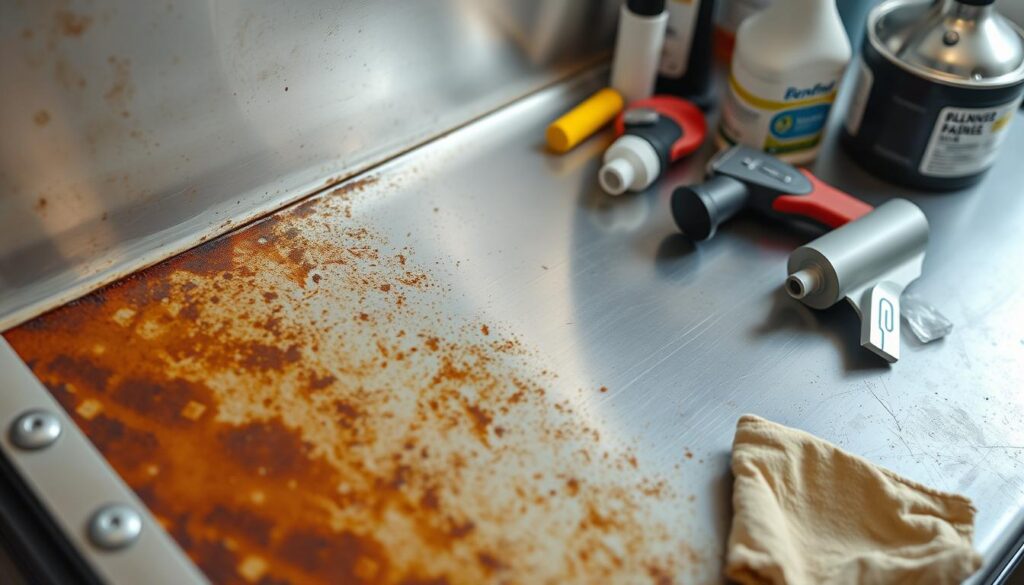
Conclusion
Getting rid of rust from stainless steel doesn’t have to be hard. Knowing why rust happens and knowing how to remove it helps a lot. You can use simple things like vinegar and baking soda, or products like NOX-RUST® Rust Preventive oil. There are many ways to fix this issue.
We’ve looked at different ways to remove rust and talked about keeping stainless steel in good shape. By cleaning regularly and not using strong chemicals, you can stop rust from coming back. This keeps your things looking new.
The key is to take care of your stainless steel before problems start. Choose cleaning methods that work best for you. Remember to check your items often. This will help them stay shiny and strong for a long time.
